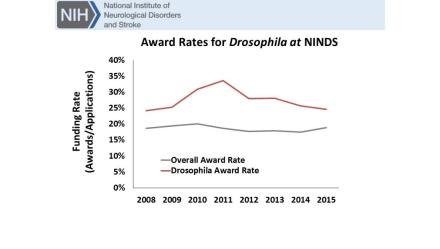The mission of NINDS is to seek fundamental knowledge about the brain and nervous system, and to use that knowledge to reduce the burden of neurological disease. We frequently receive questions about whether NINDS prefers one animal model over another. NINDS’ mission is impartial to the model system employed, but is advanced by the neuroscientific impact of each research project. We would not presume to instruct investigators on what model to employ to answer the question they are most passionate about pursuing. Rather, we have great respect for the peer review system, where each scientist has the opportunity to make his or her case to a review committee. Given constrained resources over the past 12 years, we realize that the peer review process has become taxed, but we feel that it remains the best and most democratic system in the world.

Graph of Award Rates for Drosophila at NINDS
Neuroscience applicants using invertebrate model systems have successfully competed for NINDS grant funding in peer review in recent years. For example, the NINDS award rate for Drosophila melanogaster grants has consistently been higher than the overall NINDS award rate (~25% compared to ~19% in 2015). Since 2008, Drosophila research consistently has received ~5% of all NINDS awarded grants, and Caenorhabditis elegans projects have ranged from 1-3% of NINDS awarded grants. This success rate is not influenced at all by NINDS program directors but is solely a manifestation of peer review’s perceived value of the tools available in invertebrates to uncover principles of nervous system function.
Some recent exciting advances from NINDS-funded invertebrate research comes from Dr. Paul Taylor from St. Jude Children’s Research Hospital (Memphis, TN) and Dr. Ron Davis from The Scripps Research Institute (La Jolla, CA). In a publication in the journal Nature, Dr. Taylor and colleagues used Drosophila to reveal a new mechanism of neurodegeneration, showing that amyotrophic lateral sclerosis and frontotemporal dementia (ALS/FTD)-linked C9orf72 repeats induce defects in nucleocytoplasmic transport. In a publication in the journal Cell, Dr. Davis and his team used Drosophila to show sleep’s effect on dopamine-driven forgetting and accordingly, memory. Drs. Taylor and Davis are supported by NINDS and will be receiving novel R35 awards to provide sustained support for their outstanding research programs.
A recent Proceedings of the National Academy of Sciences article incorrectly stated that invertebrate research was excluded from the NIH Brain Research through Advancing Innovative Neurotechnologies® (BRAIN) Initiative. Quite to the contrary, the success rate for Drosophila applications to BRAIN funding opportunity announcements has been most impressive, with 8 out of 24 applications utilizing Drosophila receiving BRAIN funding, including innovative genetic engineering research by Dr. Michael Dickinson and fluorescent voltage probe technology developed by Dr. Vincent Pieribone. Indeed, the NIH BRAIN Initiative supports the use of invertebrate model systems in research to understand neural functions and recognizes that this is an important part of the neuroscience ecosystem.
For more information about the scientific advancements involving invertebrate research funded by NINDS, I encourage you to read this recent NINDS blog post.
